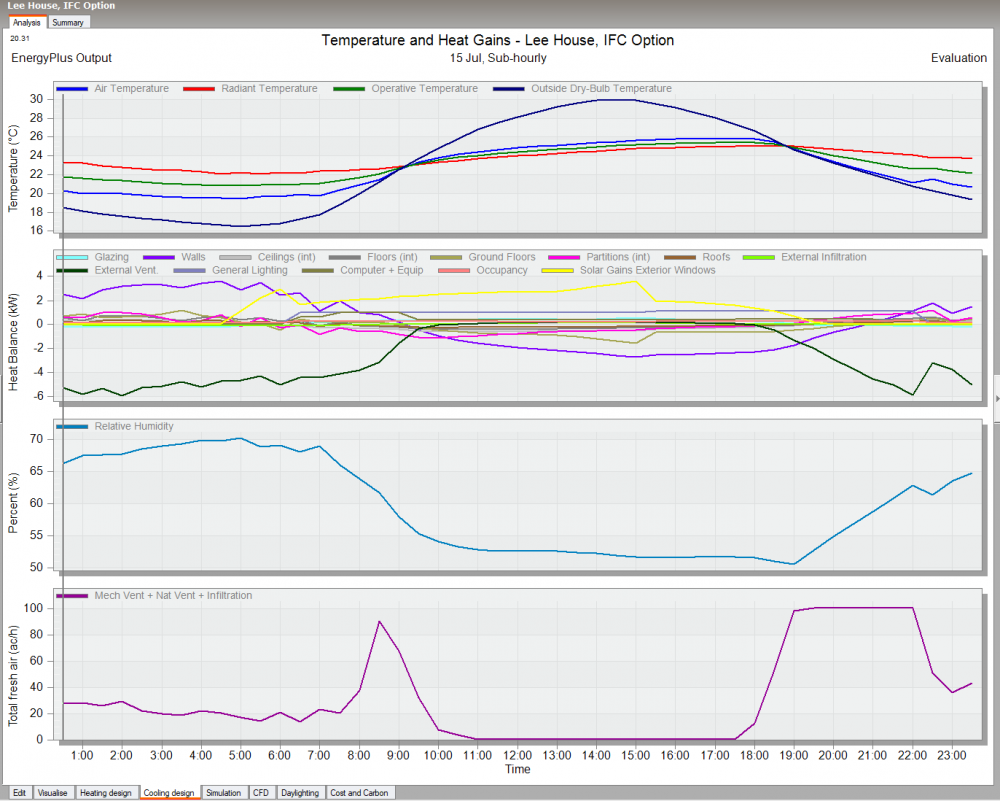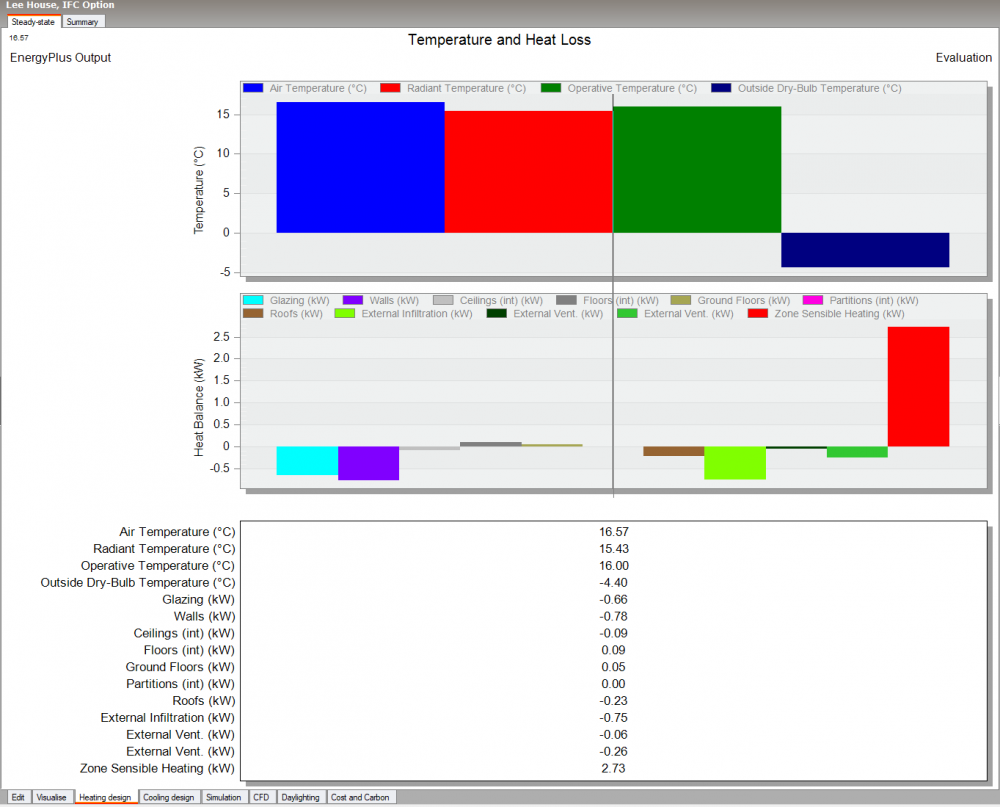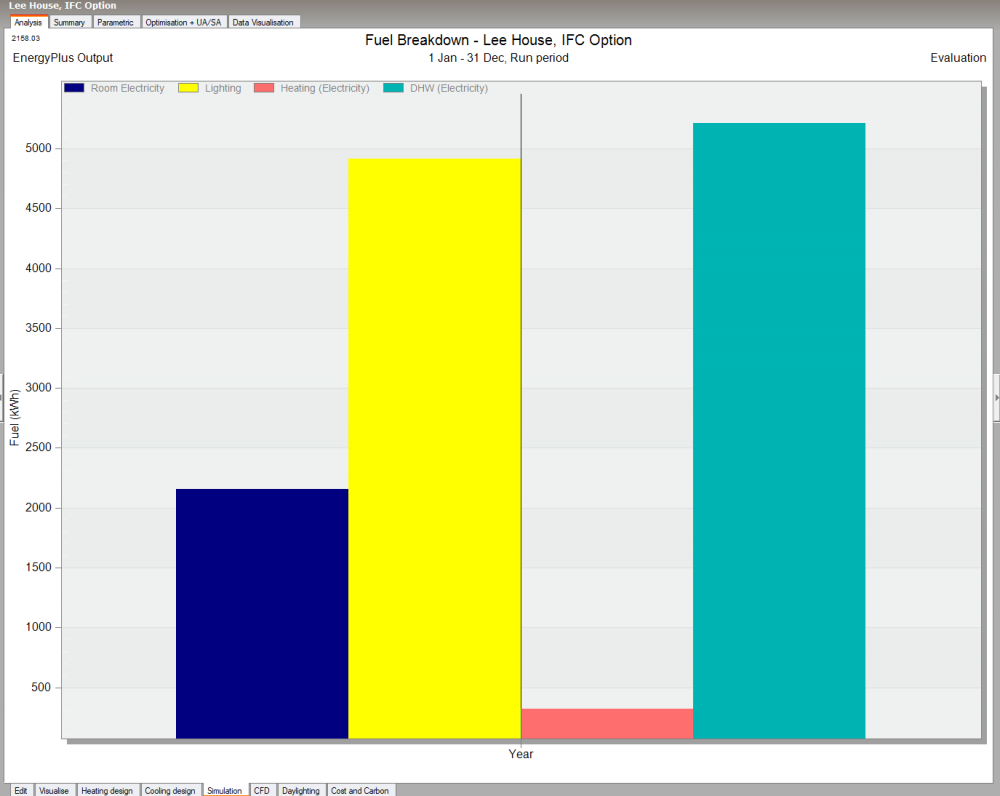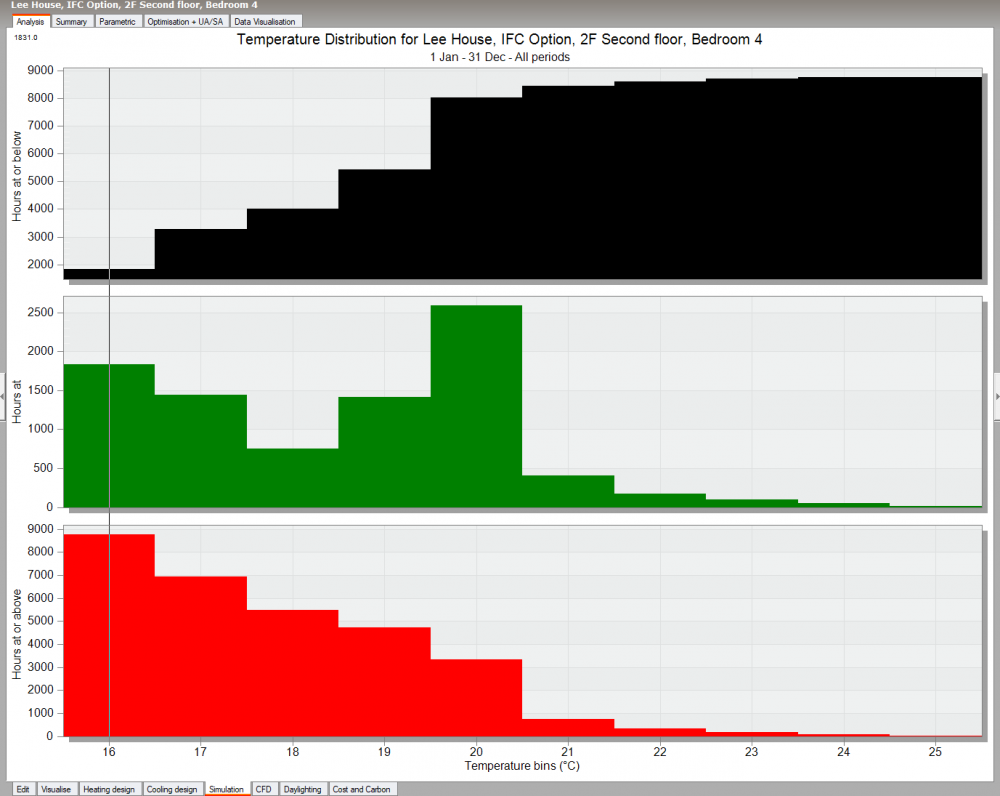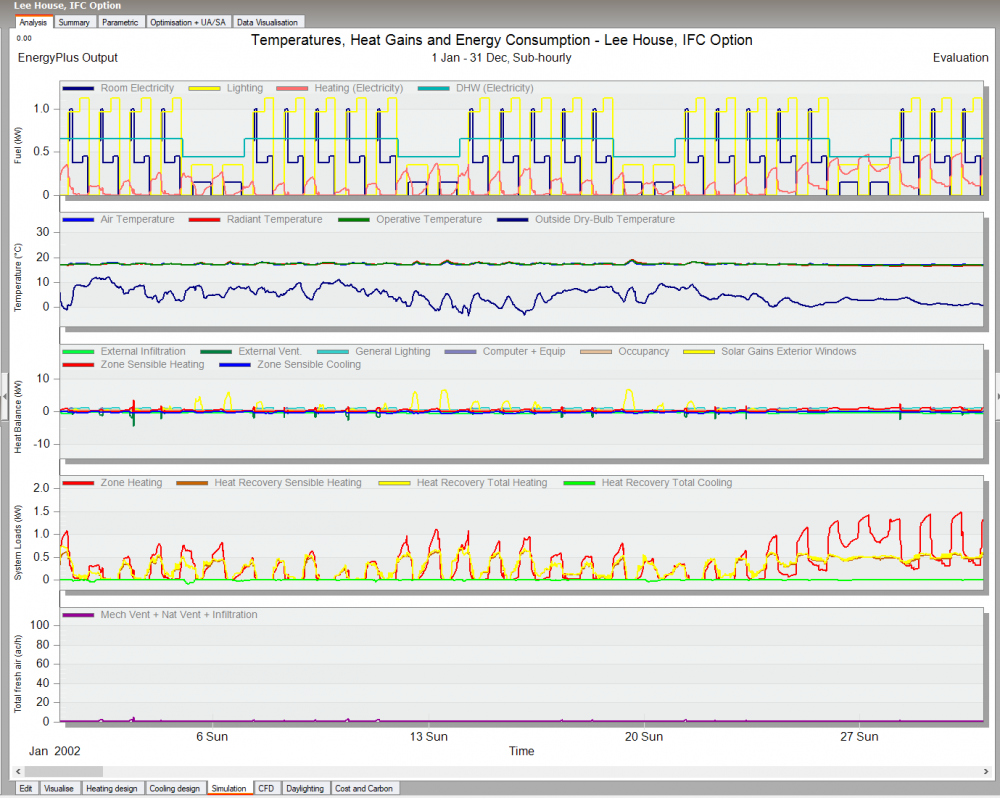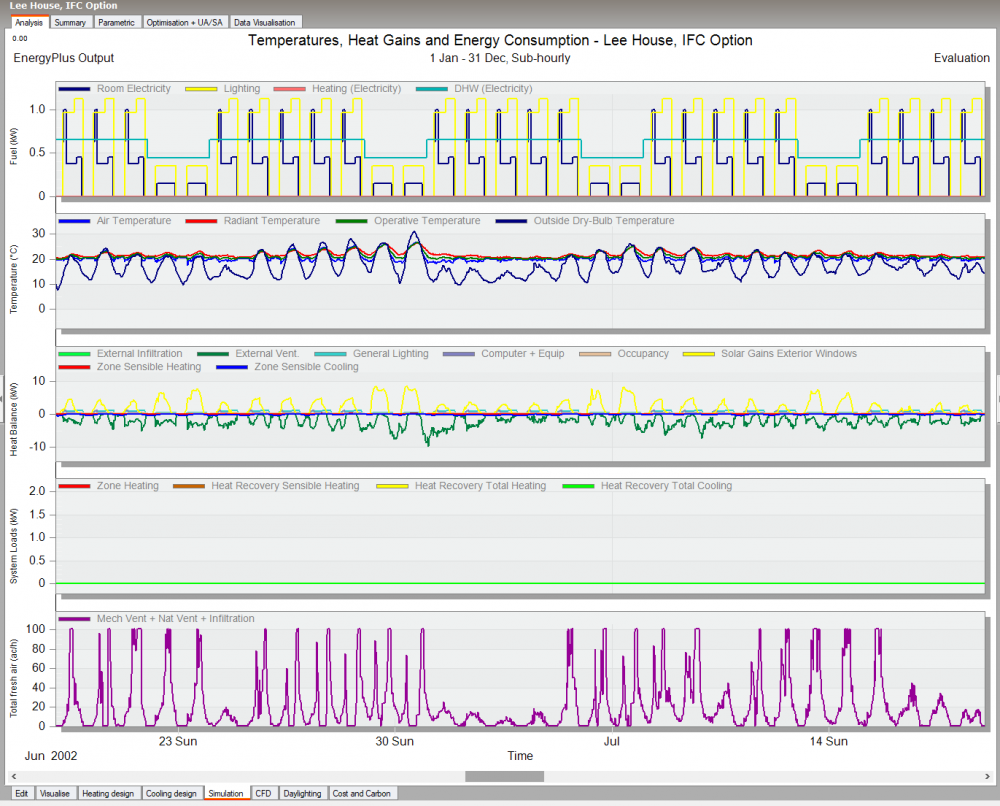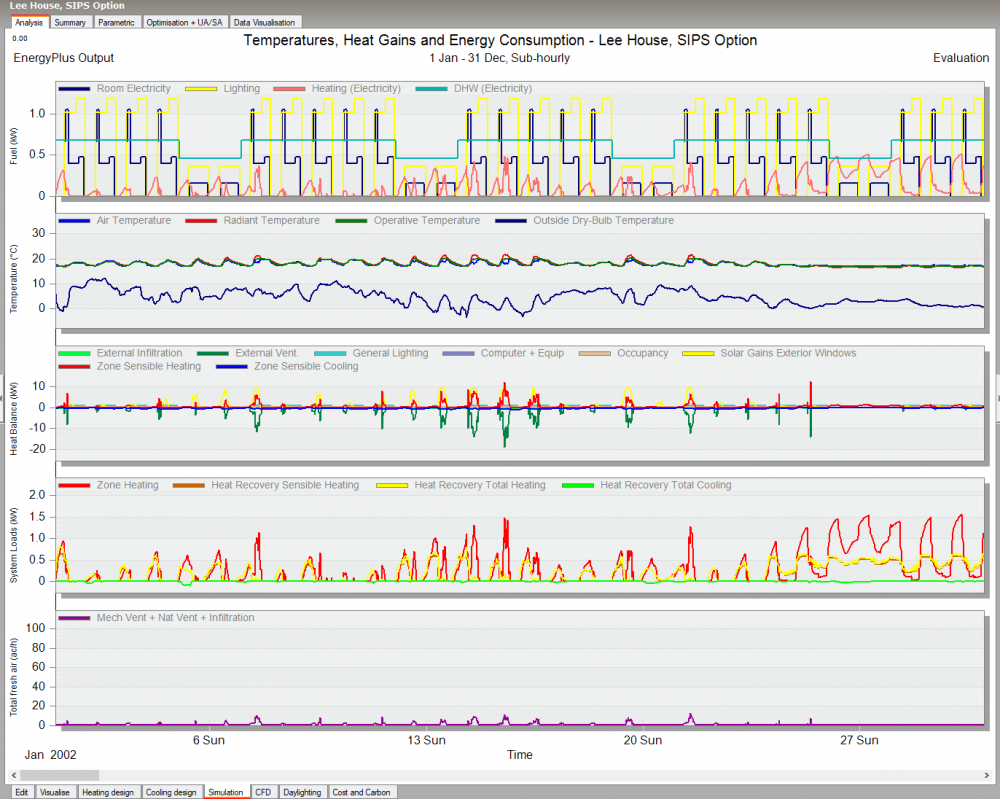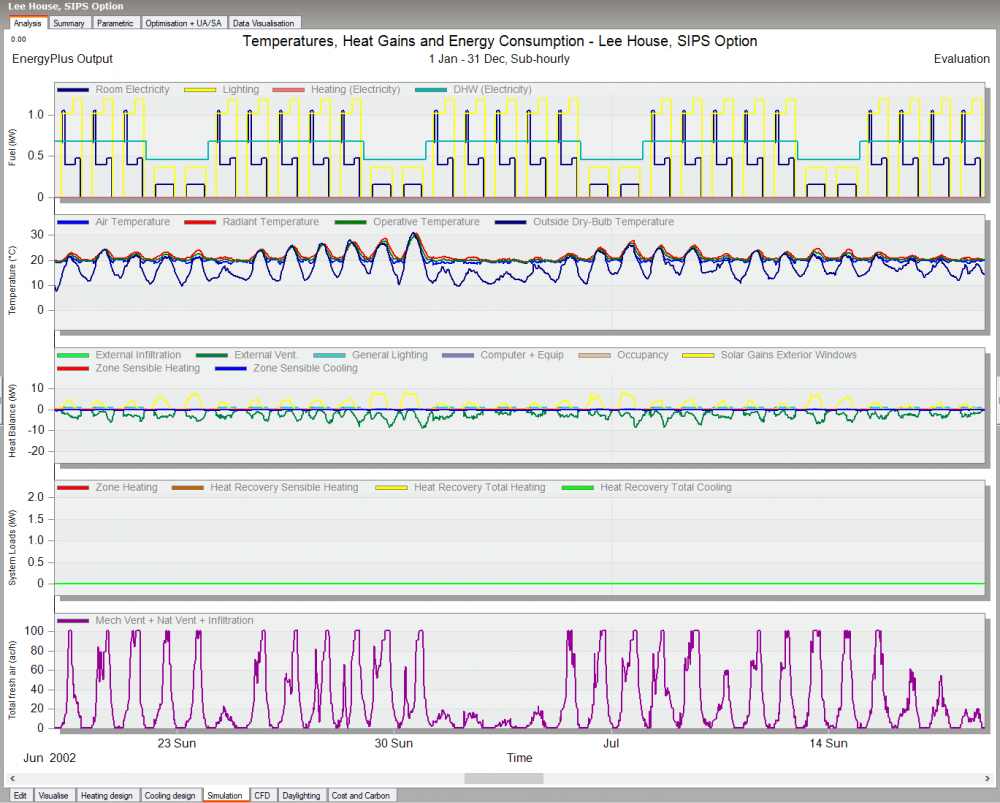
AdamJ
Members-
Posts
11 -
Joined
-
Last visited
Recent Profile Visitors
The recent visitors block is disabled and is not being shown to other users.
AdamJ's Achievements

Member (3/5)
2
Reputation
-
Hi Iceverge, For the items that aren't in the ICE database, I've had to look elsewhere for information. A lot of products have an EPD which includes A1-A3 data, but they don't separate out the embodied and sequestered carbon in the way that the ICE DB does for timber. For the cellulose, I used this EPD from Soprema (Conventional Loose-Fill Cellulose Insulation - Transparency Catalog (soprema.ca)), where they mention sequestration of carbon but don't give a separate negative figure. I assume that the figure they give is 'net' and does take it into account. All my 'in use' figures come from the Designbuilder simulations, which is based on Energy Plus. I'm no expert, but I understand that PHPP does not perform a dynamic simulation, so the two pieces of software must be using different methods behind the scenes to get their results. To make things easier for myself I didn't use the version of the model that I modified with smaller windows and brise soleil, so I know the overheating is worse than it could be, but hopefully it is a fair comparison of the different build-ups. In the current climate the variation between the build-ups doesn't seem very large, its only in the more extreme future scenario that they start to look more different from one another. Hi oldkettle. Yes I just assumed wooden cladding for those option. I hadn't thought too much about finishing and maintenance, but you're right it would probably need to be painted. I grew up in a painted wooden house so that doesn't seem too bad to me! An intriguing option is acetylated timber like Accoya, which is supposed to be much more durable that typical softwood cladding (it has a 50 year warranty). I think the process will increase the carbon footprint compared to standard wood, and the price. I could probably find out the carbon footprint for comparison's sake. Hi Adsibob, thanks for the welcome. I started out looking at auction catalogues and plots that were put up for sale on Rightmove, but decided that after a while that was a dead end. There was almost always something really wrong with the plots that were actually up for sale that, to the extent that a lot of them border on scams. They description always says something like 'potential for development subject to obtaining the necessary consents', and then I would dig into it and find out the site is actually only accessible from a private road, and the owner of that road refused to give permission (or something equally bad). I came to the conclusion that the good sites never made it to the open market - the agent would offer it up to a local builder or developer they knew who would snap it up - so only the total duds were actually listed for sale. I just started walking or cycling around, and taking pictures of spots that looked like they had potential. When I got home I would look up the owner on the land registry and search for any planning application that might have already been made on the site. If it looked promising I would write to the owner at the address given on the land registry. Mostly nobody wrote back. Sometimes people would write back, but not because they wanted to sell. Eventually one wrote back to say they were interested in hearing my offer, and that was the start of the negotiation. I think it took 70+ sites before I got that positive response.
-
Hi Guys, Update to my comparison of different methods. I have now looked at the performance of a more typical Part-L compliant masonry cavity wall as a baseline comparison, a full fill masonry cavity wall to the same 0.15 max U-value I was targeting for the other systems, and a solid masonry wall (using hollow concrete blocks) with external insulation, which to me seems the best way to do a cheap but high performance masonry wall (though it is the thickest wall so far). I've also looked at the embodied carbon of the twin-wall timber frame with cellulose insulation (its the lowest so far), and the 'perfect wall' timber frame with external GPS insulation. I did manage to find the embodied carbon of the fire retardant, the acrylic render and also low-carbon basalt reinforcement as an alternative to steel. I still have to look at the embodied carbon of all the masonry systems, and I haven't looked at a woodcrete ICF system yet for either performance or embodied carbon, so there are still gaps. I also want to separate out the embodied carbon and sequestered carbon in the timber, so that both are shown in the table, rather than just the net negative figure. I'm interested in how the embodied carbon of the masonry options compare. Energy use wise, there really isn't that much in it - even the 'standard' notional Part L compliant system isn't that bad (but it does have the same SIPS roof, high performance windows and a heat pump like all the others - its just the walls that have changed) though I imagine real world performance will be worse because of the difficulty of achieving the targeted performance with traditional masonry cavity wall construction. I've been doing Passive House 'bite size' training over the last couple of weeks (4 x half days) and seen a lot of photos of shoddy masonry walls with big gaps between insulation boards etc. I've also been told a lot about the difficulties of getting a timber frame airtight with an internal membrane due to internal junctions, which makes me think it will be easier to get good airtightness from the 'perfect wall' set up because its an external wrap with far fewer penetrations. Typical Masonry Notional Part-L (GPS Insulation) Masony Cavity Full FIlled (Rockwool Insulation) Masonry External Insulation (GPS Insulation) Wall performance (worse air infiltration assumed) Wall thickness 439 mm 463 mm 490 mm Un-usable wall thickness 439 mm 463 mm 490 mm U-value 0.2 W/m2K 0.15 W/m2K 0.15 W/m2K U-value (nominal, not including bridging) 0.18 W/m2K Phase shift 11 hours 18 hours 13 hours Thermal capacity inside 218 kJ/m2K 256 kJ/m2K 299 kJ/m2K Simulation energy in use Annual energy used for heating - current climate 534 kWh 252 kWh 244 kWh Annual energy used for cooling - current climate 113 kWh 70 kWh 60 kWh Energy load for heating - winter design day 3.4 kW 2.5 kW 2.5 kW Overheating hours (assuming no cooling) - current climate 123 hours 96 hours 82 hours Annual energy used for heating - 2080 forecast climate 173 kWh 162 kWh 157 kWh Annual energy used for cooling - 2080 forecast climate 2337 kWh 1798 kWh 1677 kWh Hot summer day cooling energy - 2080 forecast climate 21.1 kWh 15.85 kWh 14.8 kWh PV array spec to deal with 2080 cooling 6 kWp 4 kWp 4 kWp Carbon produced with grid electricity for heating/cooling 2020 151.4 kgCO2e 75.3 kgCO2e 71.1 kgCO2e Carbon produced with grid electricity for heating/cooling 2080 251 kgCO2e 196 kgCO2e 183.4 kgCO2e Carbon produced over 60 year period 10815.9 kgCO2e 7656.4 kgCO2e 7175.9 kgCO2e ICF ICF + Timber floors SIPS TF: Twin wall + Cellulose TF: Perfect wall + GPS Wall performance Wall thickness 373 mm 275 mm 395 mm 416 mm Un-usable wall thickness 373 mm 275 mm 395 mm 268 mm U-value 0.15 W/m2K 0.15 W/m2K 0.14 W/m2K 0.14 W/m2K U-value (nominal, not including bridging) Phase shift non relevant 9.5 hours 14 hours 6.3 hours Thermal capacity inside 328 kJ/m2K 28 kJ/m2K 36 kJ/m2K 35 kJ/m2K Simulation energy in use Annual energy used for heating - current climate 320 kWh 261 kWh 350 kWh 315 kWh 350 kWh Annual energy used for cooling - current climate 12 kWh 52.9 kWh 148 kWh 117 kWh 145 kWh Energy load for heating - winter design day 2.8 kW 2.76 kW 2.65 kW 2.4 kW 2.6 kW Overheating hours (assuming no cooling) - current climate 58 hours 74.5 hours 144 hours 139.5 hours 142.5 hours Annual energy used for heating - 2080 forecast climate 183 kWh 176 kWh 175 kWh 159 kWh 169 kWh Annual energy used for cooling - 2080 forecast climate 1629 kWh 1713 kWh 2440 kWh 2142 kWh 2405 kWh Hot summer day cooling energy - 2080 forecast climate 14.6 kWh 15.3 kWh 21.6 kWh 19.7 kWh 21.3 kWh PV array spec to deal with 2080 cooling 4 kWp 4 kWp 6 kWp 5 kWp 6 kWp Carbon produced with grid electricity for heating/cooling 2020 77.7 kgCO2e 116.5 kgCO2e 101.1 kgCO2e 115.8 kgCO2e Carbon produced with grid electricity for heating/cooling 2080 184.1 kgCO2e 261.5 kgCO2e 230.1 kgCO2e 257.4 kgCO2e Carbon produced over 60 year period 7318 kgCO2e 10509.7 kgCO2e 9221.1 kgCO2e 10365.7 kgCO2e Embodied ICF SIPS Twin wall Perfect wall + GPS Concrete (using Cemfree) 4251.5 kgCO2e 575.9 kgCO2e 575.9 kgCO2e 575.9 kgCO2e Basalt reinforcement 498 kgCO2e 54.1 kgCO2e 54.1 kgCO2e 54.1 kgCO2e EPS insulation 5308 kgCO2e 759.5 kgCO2e 759.5 kgCO2e 5370.8 kgCO2e Growing medium 60 kgCO2e 60 kgCO2e 60 kgCO2e 60 kgCO2e EPDM 489.5 kgCO2e 489.5 kgCO2e 489.5 kgCO2e 489.5 kgCO2e Bituminous Membrane 8.6 kgCO2e PIR/PUR Insulation (Internal board) 426.9 kgCO2e 1904.5 kgCO2e 426.9 kgCO2e 426.9 kgCO2e PIR/PUR Insulation (SIPS Core) 1912.6 kgCO2e 8532.3 kgCO2e 1912.6 kgCO2e 1912.6 kgCO2e Mineral wool insulation 128.4 kgCO2e 128.4 kgCO2e 128.4 kgCO2e Resilient layer floor insulation 73.4 kgCO2e 73.4 kgCO2e 73.4 kgCO2e Cellulose insulation 910 kgCO2e kgCO2e Screedboard floor 1003.2 kgCO2e 1003.2 kgCO2e 1003.2 kgCO2e Fire retardant 66.4 kgCO2e 258.9 kgCO2e 258.9 kgCO2e 258.9 kgCO2e Acrylic render 1837.9 kgCO2e 1837.9 kgCO2e Airtight coating in Twinwall - unknown at this point Total embodied 14850.8 kgCO2e 13839.7 kgCO2e 6652.4 kgCO2e 12200.2 kgCO2e Plywood -1804.9 kgCO2e OSB -1748.2 kgCO2e -10947.4 kgCO2e -6980.9 kgCO2e -7720.4 kgCO2e Timber planks (external walls) -2941.4 kgCO2e Timber stud (external walls) -3004 kgCO2e -1351.6 kgCO2e Timber studs (internal walls) -650.5 kgCO2e -2063.9 kgCO2e -2063.9 kgCO2e -2063.9 kgCO2e Timber battens (service void) -8 kgCO2e -424.9 kgCO2e -79.7 kgCO2e -79.7 kgCO2e Timber battens (rainscreen) -469.7 kgCO2e -469.7 kgCO2e Timber floor I-joists -507.6 kgCO2e -507.6 kgCO2e -507.6 kgCO2e Timber siding -1703.8 kgCO2e -1703.8 kgCO2e Total sequestered -4211.6 kgCO2e -16117.3 kgCO2e -14809.6 kgCO2e -14664.6 kgCO2e Net embodied 10639.2 kgCO2e -2277.6 kgCO2e -8157.2 kgCO2e -2464.4 kgCO2e
-
Alternative idea: If your main concern is that their windows will provide a reason to refuse an extension of your own, what about putting in your own application now for an extension of the same size, and ask the seller to pay the fees. It would be hard for the planners to refuse you if they are going to consent your neighbour, and hard for your neighbour to object to your application whilst theirs is still live.
-
Thanks Gus, I take your point that a whole life assessment including transport and disposal would be better. I agree, though I don't know yet how to factor those two additions in easily. As SteamyTea said, the ICE database does include some transport emissions. The authors say the database has a "cradle to (factory) gate" scope, covering modules A1 to A3 in the EN 15978 standard. A1 Is the extraction of the raw materials, A2 is the transport to the manufacturing site, and A3 is manufacturing. To be more comprehensive, I should then add in transport from the manufacturing location to my site, and energy I use on site in building with those products. I'd want to have a rough idea on how large a proportion transport-to-site emissions are before putting a lot of time in comparing so many different systems. I don't have any idea how to estimate the end of life emissions! I do know that the a lot of the neighbouring buildings to my site were built around 1880-1890, and then another lot around 1960, so are between 60 and 130 years old. I hope my house lasts at least as long (longer because it will be such a good house! ) I would love to believe that SteamyTea's 500 year statistic will apply to my house. Even if it only lasts 60 years, the decision on how to dispose of the house at at the end of its life will likely fall to someone else, but I could design it so the parts could be easily re-used. If I was designing it for re-use, though, I might be looking at using steel beams and columns and pre-cast concrete planks, because these are most easily re-used in new construction projects, from what I understand. Again, before embarking on a comparison between end-of-life emissions on multiple systems I would want to find out what sort of proportion of the whole they make up. Can you give me a rough idea? Hi Ferdinand, My headline goal was net-zero carbon in-use. I also want the house to be comfortable, and then beyond that to consider embodied carbon when making the decision on construction method. I don't mind if I don't follow the passive house standards to get there, but it does seem likely that I will end up doing much the same things that a passive house would. Maybe after all of these discussions I will have come to a different conclusion on what my goal ought to be. The 320-350kWh energy use figures I reported from the Designbuilder simulation are the 'fuel consumption' totals for heating, which I think is different from heating demand in the passive house standard. The figure I'm quoting is (I think) equivalent to the figure on the electricity meter (if the meter gave me a breakdown of where the energy is spent), which takes into account the efficiency of the ASHP. I assumed a COP of 3, so each unit of electrical energy is giving me 3 units of heating energy. The passive house 15 kWh per square metre target is for heating demand, which doesn't take into account the efficiency of how the heat is delivered, just how much heat is needed. I think the equivalent figure in the design builder simulation might be the total of the figures for heating and heat recovery from the 'system loads'. For my simulated ICF house that is 755 kWh heating delivered by the ASHP and 459kWh 'free' heating from the MVHR, which would suggest the demand was 1214kWh. I'm just learning my way around this so could have things wrong - someone more familiar with passive house or designbuilder please correct me. I've also put my simulated heating set point at 17 degrees, because I personally would find that a comfortable minimum. (I also had a look at the Arup comfort tool to back up my own assumptions: Arup Advanced Comfort Tool) I think the passive house assessment has it at 20 degrees. If I change my simulation to have a 20 degree heating setpoint the heating demand goes up to 6000kWh and the 'fuel consumption' energy use for heating goes up to 1600 kWh. Because I'm interested in net-zero carbon, the figure I focused on was the energy use total, rather than the demand. On the embodied carbon front, someone from Durisol wrote back to me and copied in a manager who may be able to answer the question - if I get the figures I'll post them here because it seems a few people are interested in how woodcrete type products compare.
-
Thanks for the tip on Turner Timber frames. It looks like their Super Advanced system would be the equivalent to the buildups I've been looking at, as they include an additional internal layer of PIR to overcome thermal bridging. I've written to Durisol to ask for embodied carbon data. Isotex publish some in their EPD, but not for all their blocks, and not their higher performing blocks (see page 13 of EPD-Wood-cement-blocks-for-wall-systems-Isotex.pdf (blocchiisotex.com)) I've written to them for more information as well. I also asked them to clarify the difference between their 2D and 3D U-values - I assume the 3D value includes the effect of thermal bridging, but I'm not sure. Given the way I'm expanding this exercise to cover more systems, I think I also ought to include the more typical UK construction (masonry cavity wall) for comparison!
-
Thanks for the suggestions ZacP and NickK. I hadn't thought about either of those products. I will have a look at them and make a similar comparison to the other systems. I also had a look at the ICE database and woodcret (or waste wood chips, the main ingredient) is not on there. The different wood products have quite different carbon footprints depending on how processed they are, so I wouldn't want to take a guess. We could follow @SteamyTea 's suggestion and contact Dr Craig Jones and Professor Geoffrey Hammond - the ICE database points to the Circular Ecology contact page: Contact Circular Ecology - Circular Ecology. If I can get the info on woodcrete and cellulose (the ICE database doesn't include figures on this) then I can do similar embodied carbon sums to the ones I have done for SIPS and EPS ICF for Durisol and the twin wall timber frame versions of the house. I've started back at work today so won't have as much time to run the numbers as I did over the Xmas break, at least until the weekend.
-
Thanks for the thoughtful comments @SteamyTea and @Iceverge. Its the first time I'm looking into carbon offsetting so I am an ignoramus wading into waters that others have already mapped out quite well, but even after reading your posts and SteamyTea's article and other critical articles, I don't see how carbon offseting, if done by planting trees, is fundamentally different from using timber in construction and counting that as sequestered carbon. Here is my thought process, and I may have (probably have) misunderstood things: The production of timber building products uses energy and produces emissions. According to the ICE database, ignoring the sequestration, OSB produces 0.455 kgCO2e/kg of material. With carbon sequestration its net -1.05kgCO2e/kg. As the ICE database notes, carbon storage can only be claimed for sustainably sourced timber, and the actual amount in reality will depend on what happens to the timber at the end of its life in the building (incineration/landfill/recycling). The stored carbon was sucked out of the atmosphere during the lifetime of the tree, the net negative value we attribute to it is because in a sustainably managed forest a new tree will be planted to replace the harvested one which will again absorb carbon from the atmosphere. In the newly planted carbon-offset forest, each tree will eventually die and release carbon back into the atmosphere, but new trees will grow and replace the dead ones. As long as the forest is not cleared away, it will settle into a state of equilibrium and function as a long-term average carbon store. If I double the number timber studs in a wall it will have taken more energy and produced more emissions to create that wall, but its overall embodied carbon goes down because (if it was sustainably sourced) more new trees have been planted to replace the ones that were harvested to make the timber. On the carbon offseting pitfalls raised in SteamyTea's article, the forestcarbon.co.uk website I looked at does address most of them: The projects are in the UK, they adhere to Woodland Carbon Code devised by the Forestry Commission, which assures 'additionality' (that the carbon would not have been captured without the intervention of the buyer ie. no double counting) and permanence. Every 5 years the projects are re-certified and the amount of carbon stored is verified. Having said all that, if we ignore carbon storage (either in the timber in the building or in new forests) then it seems clear that using less material, or less energy intensive material, is beneficial. I've been looking at the performance of the twin wall timber frame with cellulose insulation as per MBC, and also a 'perfect wall' timber frame, which I saw some youtube videos about. The 'perfect wall' that I saw had, from inside to outside: 1. Studs to form structure, left open to the internal space 2. Timber boards 3. OSB 4. Air/Vapour proof membrane (in the example it was a bitumen-based sheet membrane) stuck onto the OSB 5. Insulation (in the example it was PIR, I think) 6. Cladding I like the idea that the structure is the innermost layer, and that the insulation is outside the vapour barrier. I also like that the studs were left open and could be usable internal space, for shelving for example. The insulation can't be cellulose, because it needs to be rigid, but it could be something like Pavatex, which is made from waste sawdust. The timber boards have some benefit with the lightweight insulation because it slightly increases the phase shift time, but not with Pavatex, so in that scenario it could be a single OSB sheet layer. I would prefer to replace cladding with render directly applied to the insulation, to save on wall thickness. Performance wise, there are a lot of similarities between all the walls I've looked at. The simulated house performs very well in today's climate, with very low heating energy use and no need for any cooling with all of the walls. All the timber walls (including the SIPS) perform pretty similar to each other in the 2080 climate, with the ICF doing better in keeping the inside cool for less energy. I also looked at whether omitting the concrete upper floors from the ICF option in favour of timber floors had much of an impact. It made heating slightly easier and cooling slightly harder. ICF ICF + Timber floors SIPS TF: Twin wall + Cellulose TF: Perfect wall + EPS TF: Perfect wall + Woodfibre Wall performance (from ubakus) Wall thickness 373 mm 275 mm 395 mm 416 mm 454 mm Un-usable wall thicknes 373 mm 275 mm 395 mm 268 mm 306 mm U-value 0.15 W/m2K 0.15 W/m2K 0.14 W/m2K 0.14 W/m2K 0.14 W/m2K Phase shift non relevant 9.5 hours 14 hours 6.3 hours non relevant Thermal capacity inside 328 kJ/m2K 28 kJ/m2K 36 kJ/m2K 35 kJ/m2K 60 kJ/m2K Simulated energy in use (from designbuilder) Annual energy used for heating - current climate 320 kWh 261 kWh 350 kWh 315 kWh 350 kWh 314 kWh Annual energy used for cooling - current climate 12 kWh 52.9 kWh 148 kWh 117 kWh 145 kWh 127 kWh Energy load for heating - winter design day 2.8 kW 2.76 kW 2.65 kW 2.4 kW 2.6 kW 2.6 kW Overheating hours (assuming no cooling) - current climate 58 hours 74.5 hours 144 hours 139.5 hours 142.5 hours 95 hours Annual energy used for heating - 2080 forecast climate 183 kWh 176 kWh 175 kWh 159 kWh 169 kWh 165 kWh Annual energy used for cooling - 2080 forecast climate 1629 kWh 1713 kWh 2440 kWh 2142 kWh 2405 kWh 2242 kWh Hot summer day cooling energy - 2080 forecast climate 14.6 kWh 15.3 kWh 21.6 kWh 19.7 kWh 21.3 kWh 20.0 kWh PV array spec to deal with 2080 cooling 4 kWp 4 kWp 6 kWp 5 kWp 6 kWp 5 kWp This was based off the initial model geometry, rather than the one with the smaller windows and the brise soleil, to make comparison with my first table easier. I assume that any design changes like that will have an effect regardless of the wall buildup, so I can consider them more fully later, after having bottomed out construction method. I haven't looked at the embodied energy of the newer options yet - it takes more time for me to work that out than run the simulations! @Iceverge, what did you mean about costing quadruple, need triple maintenance etc? Were you talking about a shutter compared to a brise soleil? Adam_J_Timber_Frame_perfect_wall_w_pavawall.pdf Adam_J_Timber_Frame_perfect_wall_w_EPS.pdf Adam_J_Timber_Frame_twin_wall_cellulose.pdf Adam_J_ICF_Wall_1.pdf Adam_J_SIPS_Wall_1.pdf
-
Good point ProDave. I had thought to leave out the energy generation side to simplify the decision around construction method, but it does make sense to allow for it as it is essentially another way of investing carbon now to save it in the long run, which is what I've been trying to figure out. PV The Designbuilder simulation shows that the SIPS house would use 3.76 kWh of energy to heat on a cold winters day (24 hour period) in the current climate (worst case scenario for heating), and 21.6 kWh for cooling on a hot summer day in the 2080 climate (worst case scenario for cooling). It seems like both of those could be met with a 6kWp solar PV array, which would have 15360 kg CO2e embodied carbon. Given that the heating / cooling differences in energy use between the two houses are essentially eliminated by the solar array, that leaves the embodied carbon of the construction method vs cost question as the likely decisive factor. If the higher embodied energy house (ICF) is lower cost to the extent that the differences could be more than offset with the leftover money, then from an carbon point of view that would seem to be the best choice. If the SIPS house is lower cost then that would be the best choice. Carbon offsetting Looking at the price of carbon offsetting by creating new woodland, it seems incredibly cheap compared to the embodied carbon and the energy-in-use carbon figures I've been looking at. For £10, forestcarbon.co.uk will plant 4 trees in a new woodland in the UK, which they say will offset 1 tonne of CO2e. Using those figures, the 14 tonne difference between the embodied CO2e of the ICF and the SIPS house could be offset with only 58 trees, for £140. Presumably this considered to be offset in perpetuity, but in reality accumulates over time as the trees grow. An environmental drawback therefore could be that CO2 is emitted in the present day to build the house but is only sequestered over a period of many years (I don't know at what point the 1 tonne mark is considered to have been met - in some other non-UK forestation/sequestration projects I was looking at the lifetime is 20 years). Carbonpirates.org say that a newly planted tree will absorb 5.9kg of CO2 in a year, and a 10 year old tree will absorb 22kg in a year. With that in mind I could make my carbon offset payment when I get planning permission, with say a two year timeline from that point to moving in. Using the more conservative figure for a newly planted tree I would need 1238 saplings to absorb the 14 tonnes of CO2 by time I move in, which would cost around £3100. Over the lifetime of the house those 1238 trees would absorb 309 tonnes of CO2e. Maybe I'm missing something, but I don't see how this is different from using sequestered carbon within the timber parts of the building to balance out embodied carbon in the insulation, ground floor slab etc. Or even using sequestered carbon in a timber building product to balance out the carbon generated by the extraction and processing of the tree into that building product in the first place. Thanks for the brilliant and helpful post @Iceverge Why did you shift from ICF to wide cavity wall, and why would you now go for timber frame if you were doing it again? I've messaged @tonyshouse and asked him to point me to his blog post so I can read up on brise soleil vs blinds. Based on your suggestion I ran another couple of tests in Designbuilder. Firstly on the roof: I had previously assumed a SIPs roof with a layer of growing medium on top to allow for plants, and I think the heat capacity of the growing medium meant the decrement delay/phase shift was already quite good. The ubakus calculator said the phase shift period would be 15.2 hours. Adam_J_SIPS_Roof__Growing_Medium (1).pdf Switching to a concrete roof (which has even better heat protection characteristics) Adam_J_Concrete_Green_Roof.pdfhad a negligible impact on overheating hours. Adding louvres to the south-facing windows and halving the size of the east and west-facing windows reduced overheating hours in my worst-case room by 16%. With cooling on, on the typical hot summer day 24 hour cooling energy use was reduced from 21.6 kWh to 9.5kWh, which would allow me to downsize the PV array to a 3kWp system to deal with heating and cooling (and reduce the embodied energy in that). I'm sure there is more that I could do on solar control to bring those numbers down further. I'm drawn to the idea of shutters (either internal or external) with louvres with adjustable angles, rather than a fixed brise soleil, which should allow a huge amount of control over the solar gain. I wouldn't even need to shrink the windows on the east or west side then - on an overheating day just fully shutter one half of the window for most of the same benefit (or shutter the whole thing if no one is in the room). I know its not exactly the same, as the U-values of the window + shutter are not as low as the wall would be. It seems complex to set it up right in Designbuilder though to test it properly. Your TLDR is a very good summary I will look more into timber frame twin wall / cellulose insulation options, based your and SteamyTea's suggestions. I expect performance will be somewhere between the SIPs and ICF. MBC have some useful information on their site - thanks for dropping their name. Given what I've found about carbon in use vs embodied carbon vs carbon offsetting, I think price is going to be the key factor and I need to get some rough ideas of prices for IFC, SIPS and the timber-frame option. It's likely the cheapest one will be the best from a carbon point of view because it will allow for the greatest amount of offsetting. If prices are similar enough then perhaps the deciding factor will be how easy it is to get the construction right and achieve the performance target.
-
Thanks for the design thoughts SteamyTea. Are there timber frame suppliers that you or Buildhub members recommend? I haven't thought about cellulose insulation before. From quick googling it looks like it is usually (always?) loose fibres blown between the studs. Wouldn't an additional layer of insulation in the form of a rigid board be needed on either the inside or outside to prevent thermal bridging? The only mention I could find of a cellulose board is of a research project from Washington State University: Cellulose rigid foam board Insulation, environmentally-friendly styrofoam alternative - Ecohome I didn't expect the charts to show up big like that! Its turned into a massive wall of images, but I can't edit the post to put in a summary PDF instead. For my own benefit I've summarised the differences between the two construction methods (with all my previous assumptions, no design changes yet) in a table. I forgot to add in the embodied carbon of the SIPs roof to the ICF house, so the ICF embodied carbon is even worse than I thought: In-use ICF SIPS Annual energy used for heating - current climate 320 kWh 350 kWh Annual energy used for cooling - current climate 12 kWh 148 kWh Energy load for heating - winter design day 2.8 kW 2.65 kW Overheating hours (assuming no cooling) - current climate 58 hours 144 hours Annual energy used for heating - 2080 forecast climate 78 kWh 175 kWh Annual energy used for cooling - 2080 forecast climate 1658 kWh 2440 kWh Carbon produced with grid electricity for heating/cooling 2020 77.7 kgCO2e 116.5 kgCO2e Carbon produced with grid electricity for heating/cooling 2080 173.6 kgCO2e 261.5 kgCO2e Carbon produced over 60 year period 6983 kgCO2e 10509.7 kgCO2e Difference between alternative method -3526.7 kgCO2e 3526.7 kgCO2e Embodied ICF SIPS Concrete (using Cemfree) 4251.5 kgCO2e 575.9 kgCO2e GFRP reinforcement 5574.4 kgCO2e 606 kgCO2e EPS insulation 5308 kgCO2e 759.5 kgCO2e Growing medium 60 kgCO2e 60 kgCO2e EPDM 489.5 kgCO2e 489.5 kgCO2e PIR/PUR Insulation (Internal board) 426.9 kgCO2e 1626.4 kgCO2e PIR/PUR Insulation (SIPS Core) 1912.6 kgCO2e 7286.3 kgCO2e Mineral wool insulation 128.4 kgCO2e Resilient layer floor insulation 73.4 kgCO2e Screedboard floor 1003.2 kgCO2e Fire retardant - unknown embodied carbon at this point Acrylic render - unknown embodied carbon at this point Total embodied 18022.9 kgCO2e 12608.6 kgCO2e Plywood -1804.9 kgCO2e Timber studs (internal walls) -650.5 kgCO2e -2063.9 kgCO2e OSB -1748.2 kgCO2e -8236.6 kgCO2e Timber battens (service void) -8 kgCO2e -424.9 kgCO2e Timber battens (rainscreen) -469.7 kgCO2e Timber floor I-joists -507.6 kgCO2e Timber siding -1703.8 kgCO2e Total sequestered -4211.6 kgCO2e -13406.5 kgCO2e Net embodied 13811.3 kgCO2e -797.9 kgCO2e Difference between alternative method 14609.2 kgCO2e -14609.2 kgCO2e
-
Thanks for the warm welcome and the initial thoughts guys! Steamy Tea, do you mean timber frame in contrast to SIPs? Prodave, thanks for the tip on UKBAKUS. I've inputted the two walls I have been comparing and contrasting - both perform well, but the ICF wall is better from a decrement delay point of view, given the much higher mass of the concrete. Iceverge, you're right that I'm coming at this with environmental aspirations. I share your sentiments on getting a handle on the figures, which is why I wanted to compare the energy/carbon in use and embodied carbon for the two methods (what has taken me days to figure out you have summarised in a short forum post!). It does look like the concrete house starts a century behind (more even) before cost is taken into account - something I haven't looked at yet but need to, and there are some other wrinkles I would like to talk to you guys about. Seeing as we've started the conversation here in this thread, I may as well continue! The house The house is a simple three-storey box with pitched roof. It sits at the southern end of a terrace, with the front door on the south or west elevation, and a garden to the east, with windows on the west, south, and east elevations. (The picture is the house model in Designbuildder - the windows were placed automatically by the software. I will move them around and resize them a bit at a later stage, but for now it shows pretty much the right amount of glazing). Floor area is approx 180-190 sqm GIA depending on wall thickness. I've assumed it would be heated with an ASHP with a COP of 3, with MVHR. I've also assumed the windows would be triple-glazed with a U-value of 0.6, fitted with with shutters. In use I haven't looked at energy use that would be the same in both house for lighting and applicances. ICF I've assumed an ICF system with insulation to the outside only, like Nudura One, to expose the thermal mass of the concrete to the inside air, as well as concrete floors with no additional finish on top, which also increases the thermal mass. For internal stud walls, I thought I could recycle the plywood shuttering from the Nudura One, and treat it with a fire retardant, instead of using plasterboard. I've assumed the same SIPS roof to both houses. The Designbuilder simulation, using the weather data for Gatwick, shows that the house would require 320 kWh annually to heat using electricity from the grid. On winter design day, with -5 degrees air outside, the heating load is 2.8kW Overheating doesn't appear to be a problem. Opening the windows will provide good cross ventilation to cool the house at night, which I have put into the model. The worst case room is a bedroom on the first floor, which has 58 hours over 25 degrees each year, which I think is very low. If I did want to add cooling (not really needed, but as a test) with a set point of 25 degrees, it would require a further 12kWh energy use annually. I also used a future forecast weather file produced by University of Exeter for the year 2080, which assumes 'business as usual' global carbon emissions as a worst case climate change scenario. In this scenario, the energy needed to heat the building goes down to only 78kWh annually. Overheating does become a problem though, with that worst case bedroom experiencing 1667 hours at 25 degrees or more. Turning on cooling during the summer with a setpoint of 25 degrees brings the number of hours down to 914 at a cost of 1658kWh of electricity. Maybe there are more advanced ways to set up shutters in the model that would reduce overheating but I've kept everything very simple for these comparisons. This is really about getting simple answers to the basic questions, or getting a handle on the numbers as Iceverge said. Designbuilder does use the materials to model the effects of thermal mass, and you can see there is slightly less daily fluctuation in temperature throughout the year, and on the hottest days (using the current climate) the concrete does seem to contribute to up to 5 degrees of 'cooling'. SIPS I've assumed the SIPS house would also have a concrete ground floor, with timber intermediate floors. It would be clad in timber as well. The SIPS house performs very similarly in terms of heating, with 350kWh needed annually to heat, and a winter design day load of 2.65kW. It is also cool enough in summer, though slightly warmer than the ICFs, with the worst case room experiencing 144 hours over 25 degrees. If I turn on cooling with the same setpoint, it would use 148 kWh of electricity. In the future climate change scenario, the SIPS house uses 175kWh to heat, and the worst case room overheats 1810 hours a year. Turning on cooling would use 2440kWh annually. Carbon in use Using 234 gCO2/kwH (which is the current carbon intensity estimate for London), the ICF house would 'produce' 77.7kg of carbon to heat and cool in the current climate. The SIPs house would produce 116.5kg. In the future scenario, the ICF house would produce 174kg of carbon to heat and cool, and the SIPs house 261kg, assuming the grid decarbonises to 100gCO2/kWh. Interpolating the heating, cooling and decarbonisation (big assumptions, I know), shows that over the 60 year period between today and 2080, the ICF house would have 'saved' around 3500kg of carbon compared to the SIPs house. Embodied carbon I used the ICE database for embodied carbon values. I haven't looked at the embodied carbon in elements that would be the same in both houses - windows / doors, kitchen, appliances, light fittings, sanitaryware, staircase etc. This is just about the difference between the two. ICF I've assumed I could use a Cemfree, rather than regular cement, which I think reduces the embodied carbon of the concrete from 283kg carbon per m3 concrete to 63kg per m3. The embodied carbon in the ICF house, including the concrete, the reinforcement, the EPS and the EPDM on the roof, adds up to around 15680kg. The sequestered carbon from the internal timber stud walls and the OSB in the SIPs roof adds up to around 4210kg, so the net embodied carbon is around 11470kg. SIPS For the SIPS house, surprisingly to me, the embodied carbon from the various insulations, the concrete ground floor, and the floor finishes is not far off the ICF house at 12600kg. The sequestered carbon in the OSB and the timber studs, battens and cladding is much higher though, at 13400kg, so the net embodied carbon is -800kg. The difference between the two construction methods is 12270kg, which is 3.5 times the amount saved in use by the ICF house over 60 years. I don't really know how to think about the sequestered carbon. If I halved the spacing between studs, which I would have said is a waste of material, the studwork would sequester twice the carbon. Does that mean its a good idea? If I added enough extra timber to the ICF house, it could net out the same as the SIPs house, which is a strange thought. Unknowns / further investigation I also want to look at whether there is a lower carbon alternative to steel or glass fibre reinforcement for the concrete, find out the embodied carbon in the acrylic render I've assumed I would use to finish the exterior of the ICF house (which will increase its embodied carbon) and embodied carbon in the fire retardant (which would have a bigger increase in the SIPS house than the ICF one). If one method is a lot cheaper than the other, I could use the money saved to offset carbon (paying for trees to be planted somewhere, for instance) which makes more sense to me than adding unnecessary timber into the building. I think my next step should be to get a rough cost estimate of the two houses and try and do the carbon offset calculation as well. TLDR: Simulation shows both houses perform well in the current climate, though the ICF house seems to perform slightly better due to the thermal mass. The thermal mass of the ICF house is a greater advantage the warmer the climate gets. Given the decarbonising grid, however, those savings in use seem to be outweighed by the sequestered carbon in the SIPS house. If there is a big cost difference between the two, that might swing it because savings could be used to pay for carbon offsets. Am I thinking about this the wrong way? Adam_J_ICF_Wall_1.pdf Adam_J_SIPS_Wall_1.pdf
-
Hi Buildhub, Given that I've been thinking about self-building for years, I'm amazed that I haven't noticed this forum before now. It seems like a really active and friendly place, with a lot of knowledgeable members. I've got an option on a site in south-east London (which took a lot of searching and negotiating to get), and now that I have the option my second step is figuring out what construction method to use. My goal with this house is for it to be net zero carbon, and to begin with I'm trying to do a comparison between ICFs and SIPs. I know that any construction method can be used to create a high performance, energy efficient building fabric, but both of these methods have a reputation for achieving good performance levels relatively 'easily'. I'm doing some simulations of energy in use (using a trial of Designbuilder I downloaded last week) and calculations of embodied carbon (in an Excel spreadsheet, using the ICE database) to get an idea of whether the higher embodied carbon of the concrete could be justified with lower energy in-use. I'd love to share these with you guys and get your thoughts when they are done. What is the best sub-forum to post in? New House and Self Build Design?






















